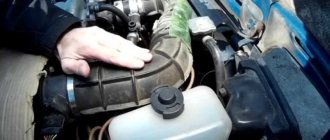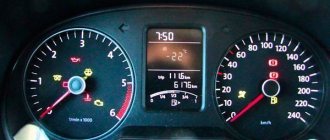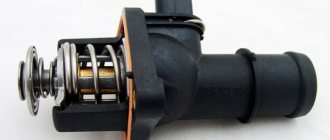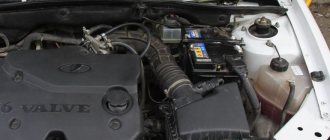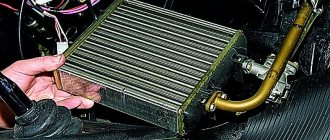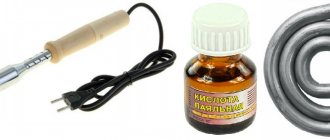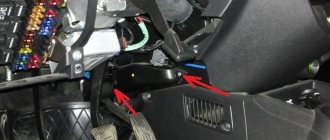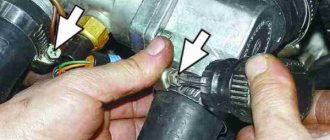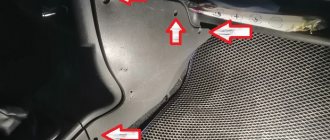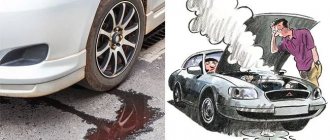A hot top and cold bottom of a car radiator is a normal condition only for an unheated engine after starting. If the engine has been running for several minutes, during which the coolant temperature has already reached 80–90 degrees (depending on the model), and the upper radiator pipe is hot and the lower one is cold, this is a sign of a problem in the cooling system. However, there are exceptions to this rule.
The main reasons why the lower radiator hose is cold after warming up are a malfunction of the thermostat or pump , or a clogged radiator . This article will tell you how to determine the specific cause of the problem and what to do in this case.
Why is the lower radiator hose cold and the upper hose hot?
- 138 6 116k
- 263 5 272k
A hot top and cold bottom of a car radiator is a normal condition only for an unheated engine after starting. If the engine has been running for several minutes, during which the coolant temperature has already reached 80–90 degrees (depending on the model), and the upper radiator pipe is hot and the lower one is cold, this is a sign of a problem in the cooling system.
However, there are exceptions to this rule. The main reasons why the lower radiator hose is cold after warming up are a malfunction of the thermostat or pump , or a clogged radiator . This article will tell you how to determine the specific cause of the problem and what to do in this case.
The engine does not reach operating temperature
You can monitor the temperature readings of the power unit directly from inside the car. The dashboard of all modern cars has a small information field, usually round or semicircular in shape, showing the driver the coolant temperature readings. This is the device that gives an idea of the temperature conditions in which the engine is operating at a given time.
If the temperature gauge does not reach 90 degrees during a long trip, you should seriously think about finding the cause of the deviation from the normal operation of the power unit. It is not recommended to delay its diagnosis, because prolonged operation of the motor in this mode will lead to wear of its internal components.
The fact is that the electronic control unit, which is popularly called the “brains” of the car, recognizes an engine that has not reached the nominal temperature as cold, and therefore the fuel system injects an over-enriched mixture.
Working in this mode leads to heavy carbon deposits on the spark plugs and, accordingly, on the internal elements of the engine, which in the future will lead to the need for a major engine overhaul.
How does the engine warm up?
Each serviceable unit has a different warm-up time. It is influenced by:
- degree of forcing;
- engine type: diesel or gasoline;
- cooling system condition;
- stove operation;
- quality of antifreeze or antifreeze;
- outside air temperature;
- type and viscosity of engine oil.
The characteristics of the oil are rarely taken into account, but experts believe that this is necessary. Various friction reducing additives and the base stock, synthetic or semi-synthetic, affect the performance in the range of 5–7 degrees. Thus, the engine will heat up faster with thinner synthetic oil.
The engine temperature gauge does not rise often due to a malfunction of the thermostat.
It is with this unit that the system check always begins if the engine takes a long time to warm up to operating temperature.
Principle of operation
Coolant enters the radiator through the thermostat. This is a large circle of fluid circulation. The thermostat usually opens at a temperature of 100 degrees Celsius. If the temperature has not reached this limit, then the liquid moves in a small circle. A thermostat malfunction is manifested by improper opening of the valves.
When the thermostat is closed, the engine overheats, and a constantly open one leads to low temperatures, since the liquid will only flow in a large circle.
Due to irregular changes of antifreeze or antifreeze, use of running water or mixing of coolants, various deposits in the form of scale may accumulate in the system. In this case, the thermostat will inevitably jam in one of its positions.
It is important to know
Beginners often make the mistake of believing that the lower pipe should never be cold, and they begin to sound the alarm.
(especially useful during winter): Drive the car into the garage. Let the engine run for 10-20 minutes so that this same pipe has time to heat up, and only then draw your conclusions. The fact is that due to the lack of heat in the cooling system (cold season), the thermostat keeps a large circulation circle closed. If the heater is on, it will prevent the thermostat from opening. Therefore, it must be turned off while the engine is warming up. If after this the lower pipe is cold, there is a problem.
Dirty radiator
The main reason for this, according to most experts, is a clogged radiator
. Over time, this important element of the cooling system becomes clogged with rust residue, dust, leaves and other debris. The location of the radiator is in front of the car. So, no matter what happens, it gets inside. As a result, all this leads to problems. Since this reason is the most important, below is a method on how to clean a radiator. In addition, proper care of the radiator and its regular maintenance ensures the normal operation of the entire cooling system.
- Or they go to the store and buy a new radiator;
- Or you can clean it yourself.
Important points:
- The radiator must be cleaned when the engine has completely cooled down;
- It is recommended to wear protective gloves and firmly fasten the car hood;
- All coolant is drained from the radiator and checked. If the liquid is perfectly clean and there are no traces of rust or scale in it, the radiator is clean and the reason for the cold pipe is different;
- If the liquid is dirty, then that's it. Pour clean water (necessarily distilled) inside. We start the engine and let it run for 20 minutes.
- We drain the water, check for cleanliness and, if necessary, repeat the procedure several times.
Coolant replacement
: Often, when replacing the coolant, beginners make a mistake and then complain about a cold pipe. This concerns a situation where the radiator itself is freed from old fluid, but the tank is forgotten. As a result, this affects the entire cooling system. It starts to act up and diagnostics give no clue.
Causes of poor coolant circulation
According to the above diagram, the reason that the lower radiator pipe in the VAZ 2110, 2114, 2115 remains cold is the lack of fluid circulation in a large circle of the system. Note that the radiator is the main cooling element. Therefore, the upper pipe through which the liquid enters the heat exchanger will be hotter than the lower one, even if the liquid circulates correctly.
Possible causes of stagnation in the cooling system:
- radiator clogged;
- non-working thermostat;
- airlock;
- pump breakdown.
Any intervention in the engine cooling system requires subsequent flushing of the ODS and replacement of the coolant. Poor quality coolant cannot cope with cooling the engine and can cause a blockage in the system.
Cleaning or replacing the radiator
The radiator, located in the front of the car, absorbs the main flow of dust and dirt. For its effective operation, timely prevention and cleaning is necessary. The radiator can become dirty both inside and outside.
An indicator of internal cleanliness is the condition of the coolant. Manufacturers recommend changing antifreeze every 75,000 km or every 5 years. However, a change in the color of the liquid, severe darkening, discoloration, or the presence of rust requires urgent replacement of the coolant. It is recommended to change antifreeze at least every 40,000 km.
To carry out internal cleaning of the cooling system of VAZ 2110, 2114, 2115, it is necessary to drain the liquid. Sequencing:
- open the expansion tank cap;
- place a container to drain the antifreeze;
- Unscrew the drain plug from the cylinder block;
- drain the refrigerant;
- unscrew the radiator drain plug (located at the lowest point);
- drain the remaining antifreeze (antifreeze);
- tighten all the plugs.
To clean, pour distilled water into the system and start the engine for about 20 minutes. Ordinary water contains many impurities and forms scale, so its use is undesirable. The liquid is drained several times until clean water flows out. This method is ineffective as it removes a small amount of deposits.
For more effective washing, it is advisable to use special chemical additives. The detergent components included in their composition allow you to dissolve deposits and remove various types of contaminants. The mixture of water and vinegar used by many motorists is less effective. It does not remove all deposits. After using chemicals, the cooling system is washed with distillate.
After cleaning the entire SOD of the VAZ 2110, 2114, 2115, an additional internal flushing of the radiator is carried out. To do this, you need to detach the hoses from the base and the upper and upper tank. Liquid is poured into the radiator through the upper pipe using a garden hose. Flushing is carried out until clean water flows from the lower pipe.
The removed radiator can be externally cleaned to remove dirt, insects, and sand from the cooler honeycomb. Cleaning is carried out with a soap solution or special devices that create a strong flow of water or air, for example a Karcher vacuum cleaner. The procedure should be carried out carefully so as not to bend the radiator honeycombs.
If damaged or heavily soiled, the radiator should be replaced.
Replacing the thermostat
If the thermostat valve does not operate correctly, the coolant does not circulate throughout the large circle of the ODS. The lower pipe remains cold even after the refrigerant is heated to 90°C. The top pipe may be hot due to steam escaping. The thermostat can also get stuck in the open position; in this case, the engine does not warm up to the required temperature or takes too long to warm up.
Removing the air lock
Signs of the formation of an air lock in the cooling system are rapid warming up of the car to high temperatures and poor performance of the interior heater. This can be especially easy to notice in winter. The reasons for the appearance of an air lock are different:
- incorrect filling of coolant;
- engine overheating;
- depressurization of the system;
- damage to some parts, etc.
If, during the inspection, leakage of antifreeze (antifreeze) is detected in the system, traces of coolant on the engine or other places, the causes of the leak should be eliminated. Often depressurization occurs due to poor tightening of clamps on pipes and hoses. They need to be tightened up. Any deformed or faulty parts found should be replaced.
There are several ways to remove air pockets. The easiest one is to drive up a steep hill with your face up. Unscrew the radiator and expansion tank caps. Let the car warm up for 10-15 minutes. Then release the gas a little and fill the system with coolant to the required level. Continue until bubbles stop appearing.
In VAZ 2110, 2114, 2115 cars, airing is rare. The cause of similar symptoms may be clogged hoses or radiator.
Filling with new coolant Kalina
The installation of new pipes is complete. Now the most interesting part is that you need to fill in new antifreeze. Don't forget to tighten the bolts from the drain holes back. I use Felix Green G11. To avoid the occurrence of a large number of air pockets, before filling in the coolant, I removed one hose from the throttle heating - the highest point of the cooling system. During the process of filling the system, air could be heard escaping. Out of 10 kg of antifreeze, about 2 liters remain in the canister.
I filled it up to the MAX mark on the expansion tank and put the hose from the throttle back in place. Now you can try to start the engine and see what happens. Before this, of course, you need to put in place the ignition module and the air filter along with the mass air flow sensor and the adsorber valve.
After the first start, the engine heated up to 120 degrees, but the radiator remained cold. I waited about 10 minutes until the engine cooled down and SLOWLY unscrewed the cap from the expansion tank, releasing the pressure, and then unscrewed it completely. At that moment I heard a gurgling sound - excess air was coming out. Some fluid has leaked into the system. I added new fluid to the reservoir and started the engine again. This time everything worked as it should - the radiator warmed up, the fan turned on, the stove was heating, the temperature stayed around 90º.
And on this positive note, the procedure for replacing the pipes on Kalina, as well as the thermostat and antifreeze, can be considered completed.
Cooling system hoses are inflated
First things first: Passat car 1995, ADZ engine - 1.8l. How it started: antifreeze began to leak from the gap between the tee (which has a temperature sensor) and the engine. Because it was minus 30-40 outside and there was no desire to climb, I just added antifreeze as needed. I didn’t pay attention to the pipes and others (if there is a leak, you first need to seal it, and only then look further) Now it’s warmer and on Sunday I fixed all the leaks (I found 2 more).
The problem is this: the hoses on the radiator inflate and antifreeze is forced from the expansion tank into. I think the cooling system. What I have already done (except for eliminating the leak): - I made sure that the fan on the radiator is working and it seems that the thermostat in the engine is also alive. I checked it this way: I started the cold engine and checked the temperature of the radiator with my hand. At the beginning, only the top became warmer (the bottom was cold, that is, there was a temperature difference and that meant the thermostat was closed). Using the temperature sensor on the dashboard, I waited for the temperature to be approximately 90 degrees and touched the radiator - it was equally hot from the top and bottom and on the sides - in general, it was hot everywhere. So the thermostat opened. I sat down again and pressed the gas, like warming it up (it’s like minus 10 outside) for about . (but less than 95) degrees the fan turned on and quickly cooled everything down to less than 90. - I tried to expel the air from the stove. I don’t know the technology for passats, so I did it as I once did on the figure eight - I sharply squeezed the lower pipe with my hand (like creating pressure). I tried to drive it out by starting the engine with the cap on the expansion tank open. In general, I don’t know if I kicked it out or not, but the stove heats up like crazy. At the same time I noticed this thing - antifreeze is constantly being released into the reservoir through the upper pipe (thin). I called my mechanic and outlined the problem, but there were no ideas. I read the forum - I really didn’t find anything (except maybe change the cylinder head gasket - maybe gases are breaking into the cooling system. But there is no oil or foreign smell in the coolant.) I’ll take off the spark plugs at lunchtime and see what kind of carbon deposits are on them.) A month ago the changers were black, like rich mixture, but this is understandable - it’s still minus 40, idling for 6-8 hours, starting cold, etc.) In general, I don’t know what to do next :-(((Help with advice.
Do it yourself: Replacing the pipes of the engine heating boiler and stove
So, we continue to prepare for winter, I recently noticed a leak from the pipe of the engine heating boiler, although the liquid did not leave, I decided to replace both pipes, since they were still standard and had already been like that for 7-8 years.
Also, a crack was discovered on the incoming pipe of the stove, they are also factory, it turns out they have been driving for 12 years, I also decided to replace both.
To do this, I bought 2 sets of pipes for the injector (one of the pipes is shorter on the carburetor), 0.5 meters of diesel-resistant hose of suitable diameter, clamps, a flexible socket screwdriver with a set of 1/4 heads - I’ve been wanting to buy it for a long time, since it’s difficult to get to clamps and bolts with a regular wrench or screwdriver. I also prepared plugs and sealant, since I decided not to drain the antifreeze.
The short pipe included in the kit is ideal for the heater; it just needs to be trimmed, but the long one is a bit short, so I got a 0.5 m fuel hose from a spare parts store for tractor-trucks, and in theory it should also hold antifreeze.
First, we remove one end, put on a hose with a chopper, then the other, no liquid came out of the entrance to the head at all. Only 100 ml came out from the bottom hole in the block while I was putting the pipe on.
The standard pipes have turned into hard plastic.
I also replaced it on the stove, after closing the faucet, the liquid didn’t even come out. I simply tore the factory clamps with a screwdriver, installed normal ones, and, where possible, coated them with a thin layer of sealant.
The pipes were also hardened to the point of plastic.
Also, one of the connections of the recently rebuilt faucet began to dig again. Apparently, he didn’t wind up enough fuma.
I decided to try expensive plumbing fixtures, as they say, they are suitable for aggressive environments and for moving joints. The structure is reminiscent of flax fibers, only synthetic and already impregnated, I wound it thicker to be sure.
I didn’t de-air anything, the heater works well, the car doesn’t overheat. It's been a couple of months and everything is holding up.
At the same time, I replaced the air filter, which I do every year in the winter.
Flexible screwdriver - 100 RUR
Set of heads 1/4 - 225 RUR
Stove pipes - 120*2 = 240r
Air filter - 205 rub.
Subscribe! Good luck on the roads!
- More about this car:
- Logbook
- Breakdowns
- I fell into a hole on the highway, I thought I slipped through, but after... 218,000 km
- The beginning of the story: ... 218,000 km
Once again, it is worth praising the author for a detailed review supported by close-up photos. Well, once again I can’t resist a couple of comments.
There would be no need to fuss and close the faucet, the effect would be similar. (if the radiator cap was closed at the same time), Further, judging by the photo, the clamps were far from being factory ones, because from the factory there were band clamps, not worm-type clamps. Well, using sealant in these places is not good.
In fact, the reason for the “undermining” is not in the small number of turns of the tape, but in something completely different. The respected author probably used FUM tape with a thickness of only 0.08 mm. It is usually sold everywhere and is cheaper than other analogues
It seals threads even of a modest size of 1/2 inch very poorly. Therefore, a little advice when buying a tape is to always pay attention to its thickness (written on the side of its reel) and purchase a tape with a thickness of at least 0.1 mm, or better yet even thicker. In addition, I hope that he knows that he should wind clockwise and the number of turns of the tape at the start of the thread should be less, and at the end - more (figuratively speaking, as if on a cone)
Something like this.
Causes of poor coolant circulation
According to the above diagram, the reason that the lower radiator pipe in the VAZ 2110, 2114, 2115 remains cold is the lack of fluid circulation in a large circle of the system. Note that the radiator is the main cooling element. Therefore, the upper pipe through which the liquid enters the heat exchanger will be hotter than the lower one, even if the liquid circulates correctly.
Possible causes of stagnation in the cooling system:
- radiator clogged;
- non-working thermostat;
- airlock;
- pump breakdown.
Any intervention in the engine cooling system requires subsequent flushing of the ODS and replacement of the coolant. Poor quality coolant cannot cope with cooling the engine and can cause a blockage in the system.
Dirty radiator
The main reason for this, according to most experts, is a clogged radiator
. Over time, this important element of the cooling system becomes clogged with rust residue, dust, leaves and other debris. The location of the radiator is in front of the car. So, no matter what happens, it gets inside. Ultimately, all this leads to problems.
Since this reason is the most important, below is a method on how to clean a radiator. In addition, proper care of the radiator and its regular maintenance ensures the normal operation of the entire cooling system.
Once it has been decided to start by flushing the radiator, to eliminate the symptom described above, proceed in different ways:
- Or they go to the store and buy a new radiator;
- Or you can clean it yourself.
Coolant replacement
: Often, when replacing the coolant, beginners make a mistake and then complain about a cold pipe. This concerns a situation where the radiator itself is freed from old fluid, but the tank is forgotten. As a result, this affects the entire cooling system. It starts to act up and diagnostics give no clue.
The lower radiator hose is cold and the upper hose is hot, what is the reason?
, 05 Dec 2013 17:23
- Page 1 of 7
- 1
- 2
- 3
- Further
- »
- To reply, please log in to the forum first.
#1
- Omega waters
- 72 Posts:
- Gender: Man
- Vehicle characteristics: Opel Omega, 1992, gearbox-5, C20NE (without lambda)
- Name: Alexander
- Donetsk city
Hello everyone, OOA C20NE, my lower radiator pipe is always cold, while the top of the radiator and the pipe itself are hot, what could be the reason? Of course, I understand that this could be a plug or the thermostat is sticking, the lower radiator hose is cold, while on the tidy it’s 100-105 degrees, and when I turn on the heater (it’s blowing hot), the temperature in the cabin drops by 90 degrees throughout) so as not to boil the upper part The radiator is hot, air is expelled. What could this be? I replaced the thermostat, it didn't help! and one more thing I noticed is that there is no pressure in the system! The pipes are all soft, and when you try to unscrew the cap from the expansion tank with the engine turned off, no hissing occurs!
- Top
#2
- Gender: Man
- Vehicle characteristics: Opel Omega B, 1998, manual transmission, X20XEV
- Name: Vladimir
- City: Velikiye Luki
How's the pump doing? Have you tried bleeding the radiator? You can also check the opening thermostat in hot water, maybe it will.
- Top
#3
- Gender: Man
- Vehicle characteristics: Opel Omega, 1992, gearbox-5, C20NE (without lambda)
- Name: Alexander
- Donetsk city
squeezes the pipe
Sanderis » November 16, 2013, 00:06 » Message No. 200394
Guys, help! The engine is cooling down and compressing the pipe going to the radiator. What could be wrong?
satiriaz » Nov 16, 2013, 01:19 pm » Message No. 200404
As far as I know, this is how it should be
Yuri » November 16, 2013, 14:43 » Message No. 200411
It shouldn't be this way. Either the valve is not working correctly, or there is no normal flow of liquid from the expander, or the pipe is running out.
Sanderis » November 16, 2013, 16:09 » Message No. 200416
Thanks guys) valve, do you mean thermostat?)
Alexander_01 » November 16, 2013, 16:36 » Message No. 200417
The topic has already been covered from all sides. Yuri listed everything. But most often it is a tired pipe.
X 666 » November 16, 2013, 19:39 » Message No. 200425
The sooner you change the pipe, it is already tired. I have already gone through this, see the link https://mazda-xedos.ru/problema-v-prokladke-golovki-bloka-foto-vt4949.html
Sanderis » November 17, 2013, 14:32 » Message No. 200452
I’ll change the pipe and then we’ll see if the sore goes away or not :-) thank you all for your help :-)
satiriaz » November 17, 2013, 17:50 » Message No. 200454
Damn! And a couple of years ago the service center told me that such a sunken pipe is even good! I’m still happy to drive
kakovkin1234 » November 17, 2013, 19:53 » Message No. 200458
Also check if the small hose going to the expansion tank is clogged. Mine was clogged. To check, remove the cap from the tank and blow. It should be easy to blow through.
valve » November 17, 2013, 19:57 » Message No. 200459
+1 I have the same crap with the pipe. somehow I didn’t even attach much importance to it. There have never been any problems with cooling. The antifreeze doesn't seem to go away.
Alexander_01 » November 18, 2013, 15:21 » Message No. 200468
Yes, this is not a problem at all. Just the answer to why it shrinks. He's tired. I don’t remember that members of the forum were torn from old age.
X 666 » 18 Nov 2013, 17:53 » Message No. 200474
It will definitely not burst, but the coolant from the expansion tank may not be tightened; because of this, I overheated the engine once.
DervishVit » November 19, 2013, 10:39 » Message No. 200495
I was torn when gas was leaking from under the gasket. I was lucky that it broke at the top and some liquid leaked out.
Alexander_01 » November 19, 2013, 15:16 » Message No. 200503
What to do if the engine overheats
First of all, it should be remembered that if the overheating is short-term (for example, the temperature needle rises in a traffic jam), then you should observe whether the temperature will drop after you start driving (counter air flow appears) or as a result of turning on the radiator fan.
If the car was already in motion and the engine temperature reached a critical level, you should not immediately turn off the engine. Also, you should not try to cool the engine by pouring water on it from outside, pouring cold water into the radiator, etc. Such actions will lead to the need to repair the internal combustion engine, and it may be necessary to change the BC and cylinder head.
Next, you need to wait a few minutes, while simultaneously inspecting for obvious and strong signs of antifreeze/antifreeze leakage under the car or in the engine compartment. If no leaks are visible, but the temperature does not drop, the unit must be turned off.
Please note that you need to immediately turn off the engine when steam starts coming out from under the hood; traces of intense coolant leakage are clearly visible. In this case, the engine must be stopped, without expecting that turning on the stove will reduce the heating.
CONSEQUENCES
This seemingly simple situation, like a burst radiator hose, poses a serious threat to the engine. When coolant leaks, the engine temperature instantly rises, which is associated with loss of cooling of the cylinders, where the temperature reaches more than 2000 degrees Celsius.
The consequences of overheating may result in a major overhaul of the engine with the replacement of today's expensive parts
Therefore, the condition of the rubber of the cooling system must be given increased attention.
CAUSES
Car operating experience shows that 50% of drivers are indifferent to dripping or fogging of the cooling hoses, constantly adding fluid from the expansion tank. Danger can arise for several reasons. This could be fatigue wear, which is natural during many years of use, an untightened or faulty clamp, or a pinched clamp, which is actually even more dangerous.
A pinched clamp cuts the first layer of the hose, thereby compromising its integrity; when a sudden rupture occurs, only the rubber itself knows. A burst radiator pipe will make itself known by an increase in temperature on the instrument panel or by abundant steam escaping from under the hood of the car. In such a situation, it is definitely necessary to turn off the engine and do not start it until the malfunction is eliminated.
ADVICE FROM EXPERIENCED DRIVERS
In 90% of cases it bursts under the clamp; if you cut off the damaged area, it can still be put in place with a certain interference. As a last resort, you can remove the radiator mounts, thereby increasing the length of the pipe, and secure the radiator itself using any available means. For example, a useful tip is to not fully screw the bolt that fastened the radiator into place, and place a wire tie between it and the “ear” of the radiator, which will make it immobile.
If the radiator pipe has already been cut before, it will be clearly short when cut again. In this case, you can wrap a layer of rubber under the hose, put the damaged pipe back in place, and cover the rubber layer on top with a tin strip, say, from a beer or juice can.
Place a clamp on top, and even if after this there is partial digging, you will nevertheless be able to get to the house or the nearest workshop. If the pipe did not burst, but was torn out of place, then either the clamp was faulty or not tightened, or it was due to gases entering the cooling system. This is the most severe case and you will have to use the services of a tow truck, since most likely the head gasket has broken (provided that the expansion tank cap valve is in working order).
For new cars, the problem of a burst hose is not so pressing, since new hoses serve without problems for at least three years, and there is a reason to replace all pipes at once on cars with sufficient mileage. It is not always possible to find an original radiator pipe for replacement, but the range produced by the domestic auto industry is so large that you can choose a close analogue.
CAR OWNER REVIEW
I agree with the author of the article that you can always find a way out of the current situation, which is greatly facilitated by the advice of experienced motorists. People share their experiences, describe unusual situations that may be useful to other drivers on the road. I also wanted to share my experience, or rather, how I managed to get out of a similar situation, based on previously read articles on this topic.
On the way to the dacha, the radiator pipe burst. Remembering from what you read earlier that you can increase the length of a cut hose by cutting it in half and inserting a piece of tube of suitable diameter. There was a plastic tube in the machine, prepared for just the drilled well. They cut off the required piece from it (you can cut it with a simple knife), cut the broken end of the hose in half, cut the broken end, and inserted a piece of plastic tube.
Everything was clamped with clamps and assembled in place. The connection turned out to be strong and reliable. The old hose always rubbed against the valve cover, but the homemade one now doesn’t touch the cover at all, so is it necessary to replace it with a new one? Maybe this will be a new way out of the situation for some, and for others it will refresh something forgotten.
Good luck to you and see you soon on the pages of the RtiIvaz.ru blog!
You can also familiarize yourself with other materials on pipes:
Why does the radiator pipe shrink and burst?
One of the dangerous manifestations of a malfunctioning cooling system is a violation of the geometry of the radiator pipes. Why is the situation dangerous if the inlet or outlet pipes of the radiator flatten when the engine has cooled down, and when warmed up they gradually return to their normal state? Why is this happening, can I solve the problem on my own?
About pressure in the cooling system
To effectively remove heat from the engine jacket, liquid cooling systems are hermetically sealed from the environment and can withstand pressure from 1.2 to 2 or more atmospheres. This is necessary to prevent the coolant from boiling when the temperature reaches 100°C. At elevated pressure, various brands of antifreeze and antifreeze can boil when heated to 107°C−120°C, and sometimes 150°C.
Technical means to increase pressure in the cooling system are not used. The required values are achieved due to a natural increase in the volume of heated liquid circulating in the “jacket” of a running engine. Excess pressure is released through the system expansion tank cap, equipped with special valves, in which a certain amount of air is always present.
Bends and cracks in radiator pipes
The excess air released during the expansion of antifreeze or antifreeze in the tank after stopping and cooling the engine is compensated from the atmosphere through the second check valve of the lid. If this does not happen, a vacuum is created in the tank, radiator, connecting pipes and engine jacket. The first to react to this by compression are the least durable elements of the system - the rubber radiator pipes.
The maximum possible value of negative (compared to atmospheric) coolant pressure depends on the temperature difference between the heated and cooled engine. It is no coincidence that motorists notice this problem in winter, when the temperature range is greatest. In this case, the pipes wear out quickly and, having lost their initial elasticity, can burst. The vehicle cannot be operated with such a malfunction.
Expansion tank cap: design features
In addition to the plastic body, threaded part and sealing gasket, the tank lid is equipped with two valves: inlet and outlet. Each of them is designed and must operate under certain conditions. The first opens at excess pressure - for example, 1.2 Bar. The second is needed to compensate for pressure when the antifreeze cools down. If this valve fails, a dangerous level of vacuum is created in the system.
The solution to the problem is to flush the valves or buy a new cap.
The metal parts of the valves may simply be clogged with dirt from the cooling system if it has not been flushed for a long time. In such cases, the problem can be temporarily eliminated by blowing and cleaning the lid valves. If there are repeated failures, you will have to start with a general flush of the entire cooling circuit. If the valve malfunction is due to corrosion of their metal elements, you should purchase a new cover.
How to identify a malfunction
In order to make sure that the radiator pipes are flattened precisely because of the strong vacuum in the cooling system, and the reservoir cap is to blame, it is enough to unscrew the latter a little (only on a cold engine). A characteristic whistle of incoming air will indicate a clogged or rusted check valve. If there is no whistle, you need to flush the entire system. In this case, it is better to start with the upper radiator pipe, which connects it to the expansion tank.
Why buying a new cover may not solve the problem
Unfortunately, the simplest part costing a few rubles does not always meet the requirements. The lid may not function due to a significant difference in pressure at which the valves installed in it open or close. You can check their serviceability and response threshold using a compressor for inflating tires, and adjust it by reducing the number of turns of the corresponding spring. Or simply buy and install a cover from another manufacturer.
What can be done?
If the car is not warming up well, you can inspect the thermostat yourself.
Checking the functionality of the thermostat
The design of the device implies sensitivity to changes in temperature. The pressure in the coolant system does not affect the restriction of antifreeze circulation through the small circuit, cylinder head and block cooling space. As the temperature difference between the engine and the environment increases, the thermostat gradually opens the coolant supply from the main radiator to the engine.
The same thing happens when the difference in indicators decreases. This process helps maintain and limit the temperature limit of the engine, as well as heat the interior of the car. To determine if the thermostat is working properly, you do not need to remove it.
You can detect a breakdown manually when starting the engine. When it has warmed up for 5 minutes, you can check the device.
Starting will cause coolant to circulate through the engine's cooling passages. Heating of the coolant begins in the engine and radiator of the car. The pipe going in the opposite direction from the radiator to the engine should not be hot. If this happens, then there is a problem with the thermostat.
Removing the air tube
The main reasons for poor heating in winter include air lock. It is useful for a car driver to have the knowledge and skills to remove air from the system. Its accumulation occurs at the highest point - the throttle assembly. From there you need to remove the air plug. The sequence of actions is as follows:
- Unscrew the filling cap on the engine, remove the screen and screw the cap into place to avoid contamination of the crankcase.
- Find 2 pipes, which are located side by side in the throttle assembly, and pull out 1 of them.
- Open the coolant expansion tank and cover it with a clean cloth.
- Blow slowly into the tank until antifreeze flows out of the hose.
- Put the tube back on and tighten the clamp quickly so that no air gets into the pipe.
This scheme is suitable for the VAZ 2114. When clogging of the cooling paths occurs frequently, check the entire system, which may be depressurized. If after these steps the engine temperature does not rise, then you need to look for another source of problems.
Engine insulation
By insulating the engine, you cannot get rid of all problems with warming up. If the engine is properly insulated, it will not require prolonged warming up during the day, and the coolant temperature will be normal. To insulate domestic equipment, heat-insulating material is installed between the radiator and the front grille. The motorist can use cardboard or buy special insulation.
In a purchased product, the padding consists of synthetic insulation covered with a leather substitute. It has the advantage of special holes that open when the temperature rises. Insulation can be achieved by installing a heat insulator under the hood. Special blankets have been developed for this purpose.
You can buy them or make them yourself from felt, mineral wool or other material. This type of thermal insulation helps prevent a layer of ice from freezing on the hood, which often happens in winter when snow falls on the car, melts and freezes. The heat insulator can be glued to the lower engine protection. In the future, it will need to be cleaned of dirt so that it does not get into the engine.
Let's sum it up
As you can see, there are many reasons for engine overheating, and exceeding the operating temperature itself has a very detrimental effect on the condition of the internal combustion engine. In this case, it happens that the cooling system is clean, the antifreeze level is normal, the fan, pump and thermostat are working normally, but the engine still overheats. In this case, the culprit may be the OZ, since the fuel combustion process is disrupted when the ignition angle is knocked down.
Some engines can also become very hot after running on low-quality or unsuitable octane fuel. The result of working with such fuel is a violation of the temperature regime of combustion of the mixture.
In some cases, the cause of overheating is general wear and tear of the engine and its CPG. Simply put, the piston rings wear out, and insufficient sealing of the combustion chamber leads not only to disruptions in the combustion process of the fuel charge, but also to the breakthrough of hot gases. In this situation, the motor power drops and overheating may occur.
Also, prolonged and heavy load on the engine sometimes leads to overheating. For example, jammed brake pads can make it difficult to roll, causing the driver to actively load the engine. If you add to this the car air conditioner turned on in the heat, the engine will be loaded even more.
Thermostat
The problem may also be related to the thermostat. This device is small in size and has the ability to block coolant. As a result, problems occur, including those related to the cold pipe.
By the way, the problem with the thermostat also affects the upper pipe. It can also be cold, but the bottom one, on the contrary, can be hot. All this taken together cannot in any way indicate the normal operation of the entire cooling system.
Drain the liquid from the thermostat, loosen its bolts and remove the device.
As a result, we gave three main reasons why this happens. Thus, having found out why the lower radiator pipe is cold, we draw the appropriate conclusions and act according to the situation.
Hello, sorry for the trouble. Could you help with one question? In general, the VAZ 1118 car’s heater does not heat well; one might even say it blows cold even though the engine has heated up to 80-90 degrees. I've already replaced a bunch of expansion tank caps. Does not help.
I had such a problem once, after watching your videos (for which special thanks), I removed the airlock and the stove blew perfectly. Now I can't get the air out. When I bring the fan to fire and open the cover of the engine, the antifreeze rises sharply, begins to boil and flow out, and it seems that the engine is not cooling down. I turned off the car, tried the pipes, and realized that the lower pipe from the radiator was cold, the upper one was so hot that it burned my hand.
I recently changed the pump because it was leaking, and the antifreeze was completely gone. When they changed the antifreeze at a service station, the car warmed up from 0 to 90 in 40 seconds, and the stove was blowing ice, they did something there, raised the front of the car, the plug went away, the stove started blowing well. Luzar bought the RB cover yesterday.
Tell me what could be the problem, where to dig? And why, when I open the cover of the RB while turning on the fan, I hear a strong splash and the antifreeze boils and flows. After all, you don’t have this in the video. The air was expelled normally and that’s all.
